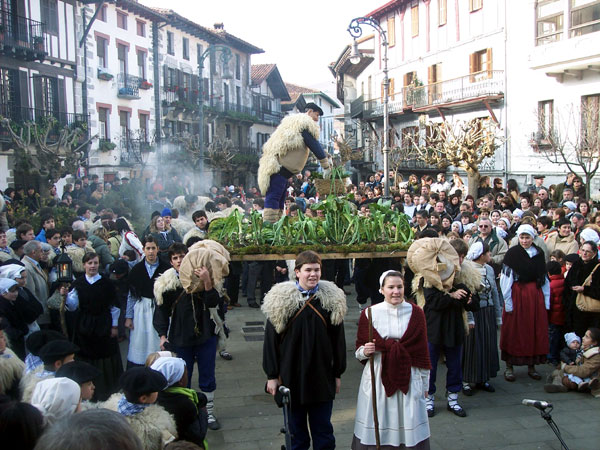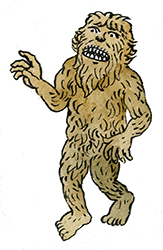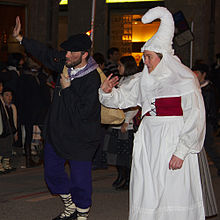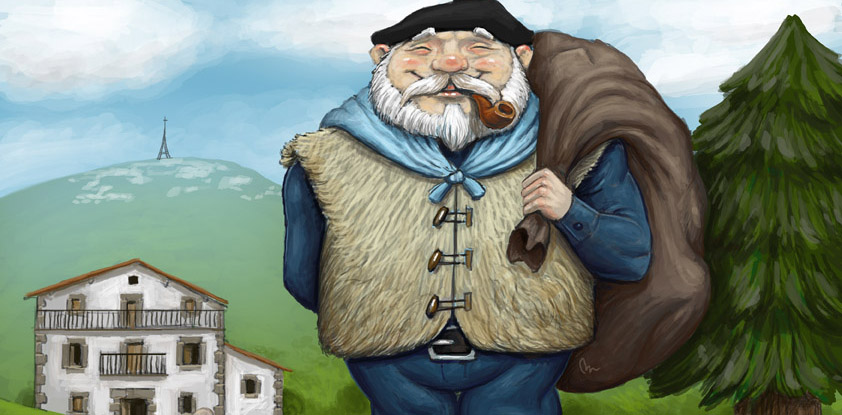Los Angeles, CA. Olentzero is a strong coalman who lives in the mountains and really likes to eat a lot. Those are almost the only traits of this widely beloved character that remain the same in the different territories of the Basque Country. From that point on, popular traditions vary from village to village, from valley to valley, and, also, among cities.
The reason for that could be that his presence in Christmas festivities –and, before that, in pagan customs− was not generalized in Euskal Herria until the second half of the 20th Century, when the number of Ikastolas, a type of primary and secondary schools, grew considerably.
Interviewed by Urola Kostako Hitza, anthropologist Oier Araolaza (Elgoibar, Basque Country, 1972) said that “the Federation of Ikastolas thought it would be convenient to have a Basque character that would represent what the Three Wise Men represented in Spain.”
Does it mean that Olentzero is a modern creation?
Not at all. It is a very old one, like most myths of most cultures. And like all of its counterparts, Basque culture has been transmitted orally for centuries. In fact, very few things had been written about Olentzero until around the 1900, when
 researchers and Academics like Resurrección Maria de Azkue, Joxemiel Barandiaran, or Aita Donostia, to name a few, did so.
researchers and Academics like Resurrección Maria de Azkue, Joxemiel Barandiaran, or Aita Donostia, to name a few, did so.
The aforementioned scholars, although having gathered different traditions, agreed on the fact that the myth of Olentzero was not equally rooted in the whole Basque land. It was mostly celebrated in the villages around the Bidasoa river, in some parts of Gipuzkoa, and in northern Navarre, by the Pyrenees. For his part, contemporary author Rafael Eneterreaga Irigoyen (Lesaka, 1942) stated that Lesaka, in Nafarroa, is the area that holds the oldest traditions connected to the Olentzero.
Be that as it may, there is one common denominator: all those territories are as in the middle of the Basque Country. Hence, offering the perfect environment for traditions to remain.
Olentzero in the Diaspora
With such a diverse and uneven knowledge of this myth, and the pretty recent spreading of the tradition, it is more than understandable why many members of the diaspora may be unfamiliar with it. For that reason, in areas were the Basques settled a long time ago, Olentzero perhaps has been lost. While in those parts were Basque immigration is either more recent or still happening, the character is still alive.
The most widespread Olentzero legend
One of the many traditions and myths that Joxemiel Barandiaran collected was the one about the Olentzero. In his writings, Olentzero was the youngest and last jentil−a race of giants in  Basque mythology. One night, a group of jentils saw a very bright star in the sky and went to ask the oldest one about it. The elder giant had no doubt: “Kixmi was born, it’s the end of our era,” he said. “Throw me into that pothole and then throw yourselves in. The youngest one of you should stay outside and cover the cave.” Kixmi, as represented in Basque mythology is a demonic monkey, was Jesus Christ, and the youngest jentil was the Olentzero, who went down the mountain to announce to the villagers the arrival of Christianity.
Basque mythology. One night, a group of jentils saw a very bright star in the sky and went to ask the oldest one about it. The elder giant had no doubt: “Kixmi was born, it’s the end of our era,” he said. “Throw me into that pothole and then throw yourselves in. The youngest one of you should stay outside and cover the cave.” Kixmi, as represented in Basque mythology is a demonic monkey, was Jesus Christ, and the youngest jentil was the Olentzero, who went down the mountain to announce to the villagers the arrival of Christianity.
Since then, the Olentzero is represented at Christmas time as a coalman –sometimes as a farmer or as a fisherman, depending on the region−. In some areas he is taken as a wise man, wearing elegant attire, and in others as a fool, dressed in rags. During the 20th Century, new features were added to this character and its traditions, like a white beard. And the fact that kids started to write letters to him, asking for presents they’d like to receive. An obvious influence from similar characters like

Père Noël and Santa Claus.
Lately, a female character called Mari Domingi, taken from a Basque traditional song that links her to the announcement of Christianity to the Basques, has been included in the tradition. She is being presented as Olentzero’s wife or girlfriend.
Older than the jentils?
Late ethnologist Juan Garmendia Larrañaga believed that the Olentzero, before being represented as a coalman and a messenger of the Nativity, was represented by a log. That piece of wood used to be burned at night and, before going to sleep, its ashes would be used to cover the rest of the trunks in the kitchen. A pair of tongs and a shovel would be put in the shape of a cross on top of that pile, to chase bad spirits away.
A very popular Olentzero song
There are dozens of songs about the Olentzero, but this one is the most popular:
Olentzero joan zaigu [Olentzero went]
mendira lanera [to work to the mountains]
intentzioarekin [with the purpose]
ikatz egitera [of making coal].
Aditu duenean [When he got to know]
Jesus jaio dela [that Jesus was born]
lasterka etorri da [he came quickly]
berria ematera [to share the news].
Horra! Horra! [There he is!]
Gure Olentzero, [Our Olentzero]
pipa ortzea duela [with a pipe in his mouth]
eserita dago [and sitting down].
Kapoiak ere baditu, [He has some capons]
arraultzatxoekin, [and some eggs]
bihar meriendatzeko [to eat tomorrow]
botila ardoarekin [with a bottle of wine].
Olentzero buru handia [Big headed Olentzero]
entendimenduz jantzia // entendimendu gabia [full of knowledge // with no knowledge at all]
bart arratsean edan omen du [last night he drunk]
hamar arrobako zahagia [120 litres of wine].
Hau urde tripa handia! [Such a fat pig!]
Tralalalala tralalalala (bis)







 Basque mythology. One night, a group of jentils saw a very bright star in the sky and went to ask the oldest one about it. The elder giant had no doubt: “Kixmi was born, it’s the end of our era,” he said. “Throw me into that pothole and then throw yourselves in. The youngest one of you should stay outside and cover the cave.” Kixmi, as represented in Basque mythology is a demonic monkey, was Jesus Christ, and the youngest jentil was the Olentzero, who went down the mountain to announce to the villagers the arrival of Christianity.
Basque mythology. One night, a group of jentils saw a very bright star in the sky and went to ask the oldest one about it. The elder giant had no doubt: “Kixmi was born, it’s the end of our era,” he said. “Throw me into that pothole and then throw yourselves in. The youngest one of you should stay outside and cover the cave.” Kixmi, as represented in Basque mythology is a demonic monkey, was Jesus Christ, and the youngest jentil was the Olentzero, who went down the mountain to announce to the villagers the arrival of Christianity.
 Send to a friend
Send to a friend Add comment
Add comment








